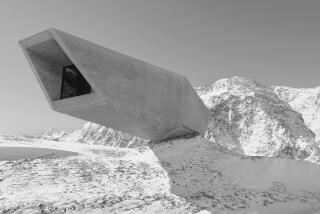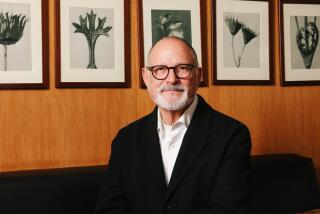Designs That Prize the Diversity of Muslims
- Share via
SOLO, Indonesia — There were Uzbek urban planners from the Central Asian city of Bokhara, a Chinese architect who had created a “bio-climatic” skyscraper in Malaysia, an Indian whose houses help Muslims and Hindus live in peace together and a grizzled Italian designer who conceived a hospital that brilliantly fits the needs of the African bush.
Brought together recently on the steamy Southeast Asian island of Java, these designers, and those responsible for eight other building projects in the Muslim world, shared in the $500,000 Aga Khan Award for Architecture.
The award, presented every three years since 1980 by Prince Karim Aga Khan, seeks to “enhance the perception of Islamic culture as expressed through architecture.” From 442 nominated projects, a master jury made a selection with an eye toward general excellence and the ability to solve physical, spiritual, social and economic needs. In particular, judges rewarded the preservation of Muslim heritage and projects that aided the poor. Diversity in concept, geography and goals was part of the point.
“Pluralism is a striking fact in the Muslim world: We want to legitimize and enhance that plurality,” the Aga Khan, 59, said in an interview during the award ceremonies. The intense, soft-spoken prince has for 39 years been the leader of the world’s 15 million Ismailian Muslims, a progressive-minded sect scattered through 25 of 44 countries in the Islamic world.
Architect Charles Jencks, a member of the nine-man jury and a visiting professor at UCLA, agreed that an important lesson of the award is that the world’s estimated 1 billion Muslims should not be seen as a monolith.
The prizes represent a “search for a path between fundamentalism and Westernization . . . the construction of an alternative tradition,” Jencks said. “Fundamentalism has taken away the voice of Islam. These are not just architectural awards. They are a cultural statement.”
For the 1995 prizes, the jury focused on three areas of sometimes overlapping architectural achievement: social aims, architectural and urban aims, and innovative concepts.
Three of the prizes awarded in the first category went to preservation efforts. The Silk Road caravan stop of the Old City of Bokhara, Uzbekistan, for instance, is back in use as a marketplace after being gutted and restored. In another commercially successful project, in the Jewish Hafsia quarter in Tunis, Tunisia, redevelopers not only physically upgraded the district, they set up landlord-tenant programs and established financial incentives encouraging rehabilitation of old structures. And in Sana, Yemen, the jury cited a project in which paved streets and restored housing in a historic district created a positive ripple effect.
Other awards in the same category went to planners who helped homeless people create self-financing, upgradeable housing in Hyderabad, Pakistan, and to a township master plan in Indore, India, in which architect Balkrishna V. Doshi created public and private spaces that encourage interaction and cooperation among the different religious groups of Indore.
Under the heading of innovative concepts, the jury awarded prizes to a mosque in Ankara, Turkey, a cultural center in Senegal, a reforestation project in Ankara and landscape design at the Jakarta, Indonesia, airport.
The mosque, part of the Turkish Parliament complex, was cited for its reinterpretation of traditional elements--the dome, for example, was replaced by a terraced pyramid.
The reforestation project, in which more than 30 million trees were planted over 35 years, brought flora and fauna back to a level thought impossible, and the airport project was honored for closely integrating indoor and outdoor spaces in tropical Indonesia.
In Kaolack, Senegal, architect Patrick Dujarric decorated every surface of a cultural center--”using African tradition,” said the jury, “in a totally original way.”
Three projects won prizes for contributions to “critical architectural and urbanistic discourse.”
One is a redevelopment around the Great Mosque in Riyadh, the mostly modern Saudi capital, that incorporates traditional Arabian desert crenelations and low, flat lines.
The “bio-climatic” skyscraper, designed by Ken Yeang in Kuala Lumpur, Malaysia, also won in this category. The building is a tube of burnished steel, punched through with a spiral of garden platforms winding up the building. The judges cited it for meeting goals of reduced energy consumption and maximum use of natural light and ventilation.
*
Perhaps the most original winner in any category was Fabrizio Carola’s bush hospital in the West African state of Mauritania. He and his team designed everything to suit the remote site, down to a new kind of brick, fired in a kiln built as a monstrous fiery-mouthed bull.
“I just looked at what was needed,” said Carola. “I felt like a Renaissance architect, with no intermediary between my design and my work. I made 2 million bricks with 40 workers and no machines. About 70% of the money was spent locally; normally 70% of the cost of such projects goes back abroad.”
Carola built the hospital’s operating theaters, wards and corridors on a fractal pattern, rather like leaves and fruit on branches. This allowed each ward to have two doors--one, inside, for use by staff and one, to the outside, for a patient’s family. In Mauritania, families often feed and tend to patient-kin.
Carola is the first to admit that most of his ideas have not caught on. In Africa, new construction is mostly made of concrete and based on European models. “The inertia of Africa is hard to beat,” he said. “It’ll take a long time for new ideas to take root. Never mind that concrete makes you die of heat and that it’s so ugly. Concrete represents the white man and civilization.”
The Aga Khan’s Architecture Award, along with his sponsorship of university architecture programs, a scholarly archive and restoration projects, will, he hopes, be a catalyst for new, universal design values.
Tasneem Siddiqui, the Pakistani official who initiated the homeless housing project in Hyderabad, had no doubt that his work was an example of this. His self-financing system showed that, once a poor family is sold a cheap patch of land and provided with infrastructure, it can and will make its own shelters, building up services and a community consciousness.
“When I drive near the projects of Chicago or the favelas [slums] of Brazil, I feel I am seeing the same as in Hyderabad,” he said at the award ceremony. “These people were written off too. I faced the same misconceptions as arise over the non-integration of blacks in America. People would tell me, ‘They are not socially organizable, they cannot learn new techniques.’ What we are trying to do is to empower people--and it’s working.”
More to Read
Sign up for Essential California
The most important California stories and recommendations in your inbox every morning.
You may occasionally receive promotional content from the Los Angeles Times.










